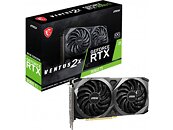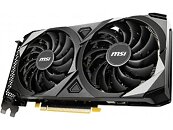Friday, January 8th 2021

MSI to Release New Revision of RTX 3060 Ti: Ventus 2X V1
MSI are seemingly readying themselves to update their RTX 3060 Ti Ventus 2X graphics card with a relatively deep revision. The new Ventus 2X V1 graphics card keeps all the same frequencies and clocks of the previous Ventus 2X (1695 MHz boost clock in the OC model), and the same TGP of 200 W. The bulk of the revisions are focused on the cards' power delivery and heat dissipation systems.
The new, revised Ventus 2X V1does away with the original's 2x 8-pin connectors, and offers a single 8-pin connector for power delivery purposes. This could mean lowered overclocking ceilings for the card, but I suppose we'll only know the answer to that when these are out there in the wild. The fact that MSI also revised the cooling system, however, seems to give credence to that overclocking headroom theory: with less power being (possibly) delivered to the card, MSI has seen it fit to make the Ventus 2X V1 a thinner card compared to its predecessor (it's a 2-slot card now, at 42 mm, whereas it was a 2.2-slot in the first revision, at 52 mm).
Source:
Videocardz
The new, revised Ventus 2X V1does away with the original's 2x 8-pin connectors, and offers a single 8-pin connector for power delivery purposes. This could mean lowered overclocking ceilings for the card, but I suppose we'll only know the answer to that when these are out there in the wild. The fact that MSI also revised the cooling system, however, seems to give credence to that overclocking headroom theory: with less power being (possibly) delivered to the card, MSI has seen it fit to make the Ventus 2X V1 a thinner card compared to its predecessor (it's a 2-slot card now, at 42 mm, whereas it was a 2.2-slot in the first revision, at 52 mm).





22 Comments on MSI to Release New Revision of RTX 3060 Ti: Ventus 2X V1
If it's anything like the one on the 2070 Super Ventus, its gonna be god awfully loud and hot.
Great to see more 2-slot current-gen GPUs arriving though.
I can have the exact gaming experience at 175w than i can using 220w, wish i experimented with lowering the power limit on my previous cards...
Also I dont have any issues with the cooler rattling.
I wonder how happy are customers about that...
It may be very slightly louder than an FE or a triple fan card but its certainly not what I would consider very poor like the Gigabyte Eagle or the Zotac dual .
This coming from someone who absolutely despises MSI since the early 2000's.